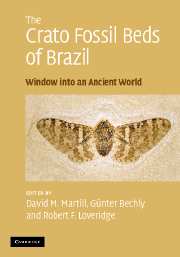Book contents
- Frontmatter
- Contents
- Contributors
- Preface
- Acknowledgements
- Part I The Crato Formation Konservat Lagerstätte
- Part II The invertebrate fauna
- Part III The vertebrate fauna
- 12 The Crato Formation fish fauna
- 13 Anurans of the Crato Formation
- 14 Turtles of the Crato Formation
- 15 Lizards of the Crato Formation
- 16 Crocodilians of the Crato Formation: evidence for enigmatic species
- 17 Pterosaurs of the Crato Formation
- 18 Birds of the Crato Formation
- Part IV The flora
- Part V Miscellanea
- Appendix: species list for the Crato Formation
- Systematic index
- Plate section
- References
17 - Pterosaurs of the Crato Formation
Published online by Cambridge University Press: 22 August 2009
- Frontmatter
- Contents
- Contributors
- Preface
- Acknowledgements
- Part I The Crato Formation Konservat Lagerstätte
- Part II The invertebrate fauna
- Part III The vertebrate fauna
- 12 The Crato Formation fish fauna
- 13 Anurans of the Crato Formation
- 14 Turtles of the Crato Formation
- 15 Lizards of the Crato Formation
- 16 Crocodilians of the Crato Formation: evidence for enigmatic species
- 17 Pterosaurs of the Crato Formation
- 18 Birds of the Crato Formation
- Part IV The flora
- Part V Miscellanea
- Appendix: species list for the Crato Formation
- Systematic index
- Plate section
- References
Summary
Introduction
The first significant account of a pterosaur from the Crato Formation was published over a decade ago (Frey and Martill, 1994). In the short intervening period between then and now, more than 30 individuals have come to light. This is a modest total, especially when compared to the 1000+ individuals recovered, for example, from the Solnhofen Limestones of southern Germany or the Niobrara Chalk of Kansas. Still, several finds notable for their completeness, or for the exceptional preservation of soft-tissue structures, such as extensions to cranial crests or of the integument associated with the foot, have already demonstrated the importance of this lagerstätte for our understanding of pterosaur palaeobiology (Frey and Martill, 1994; Campos and Kellner, 1997; Frey and Tischlinger, 2000; Frey et al., 2003c). The Crato pterosaur assemblage also contains a number of genera (e.g. Arthurdactylus, Ludodactylus, Ingridia gen. nov.) that are unique to this deposit (Frey and Martill, 1994; Frey et al., 2003b; this chapter). They represent several Lower Cretaceous pterosaur lineages and throw some much-needed light on the ecology, palaeobiogeography and evolutionary history of pterosaurs during an interval when they appear to have reached their highest levels of global diversity (Unwin, 2005).
Fragments of several limb bones from the Upper-Triassic Caturrita Formation of southern Brazil (Bonaparte et al., 2006) may represent the earliest occurrence of pterosaurs in South America.
- Type
- Chapter
- Information
- The Crato Fossil Beds of BrazilWindow into an Ancient World, pp. 475 - 524Publisher: Cambridge University PressPrint publication year: 2007
References
- 34
- Cited by



